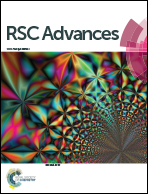Multi-stimuli responsive fluorescent behaviors of a donor–π–acceptor phenothiazine modified benzothiazole derivative†
Abstract
A novel donor–π–acceptor phenothiazine modified benzothiazole derivative PVBT, in which phenothiazine and phenothiazine groups act as donors and acceptors, was designed and synthesized. The PVBT showed strong yellow fluorescence in solution and the solid state. More interestingly, the PVBT exhibited multi-stimuli responsive fluorescent behaviors. First, the PVBT displayed obvious solvatochromism of fluorescence. Its emission wavelength was strongly affected by solvent polarity, indicating intramolecular change transfer (ICT) transition. Second, the PVBT exhibited reversible mechanochromic luminescence under grinding and fuming with THF vapor treatment on account of the reversible transition between the crystalline and amorphous states under external stimuli. Finally, the PVBT revealed remarkable and reversible acid/base-induced fluorescence switching properties in both solution and the solid state. In particular, the ground film of PVBT could also act as a fluorescent chemosensor for detecting volatile acid vapors of TFA, HCl and HNO3. These results can provide us with a new idea to develop new kinds of multi-stimuli responsive fluorescent materials.


 Please wait while we load your content...
Please wait while we load your content...